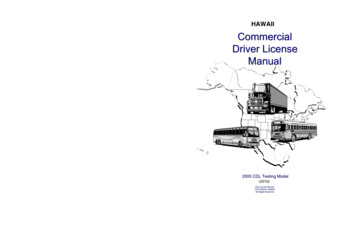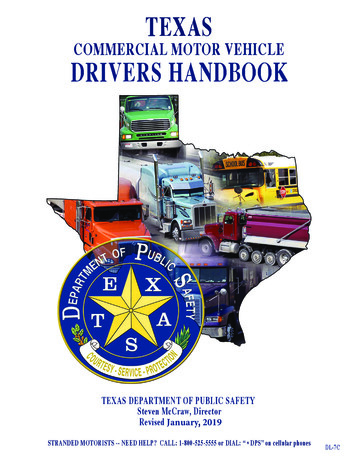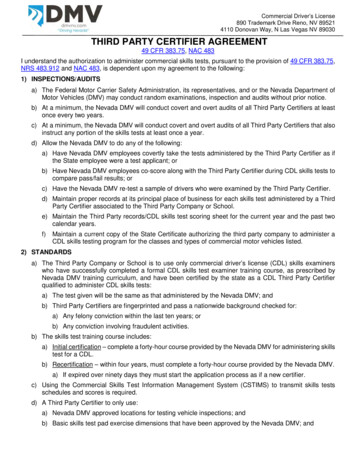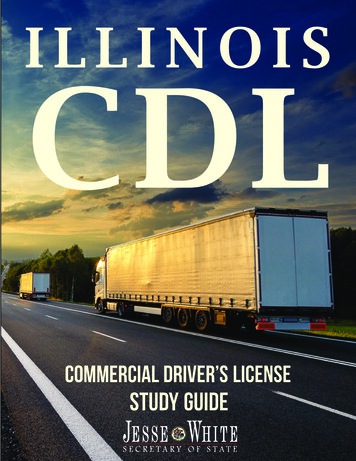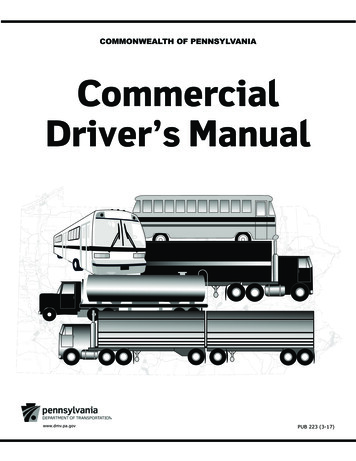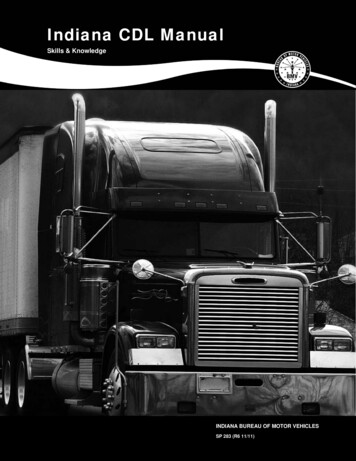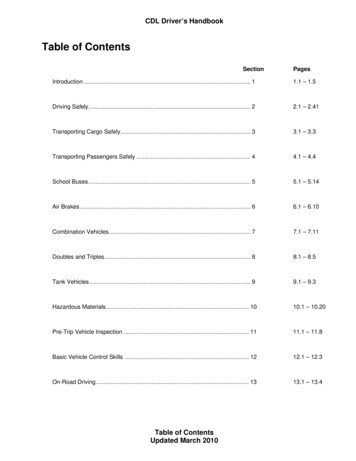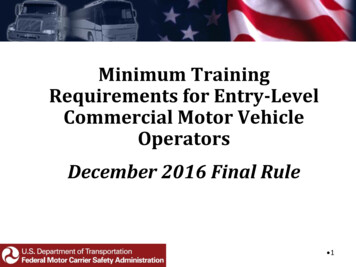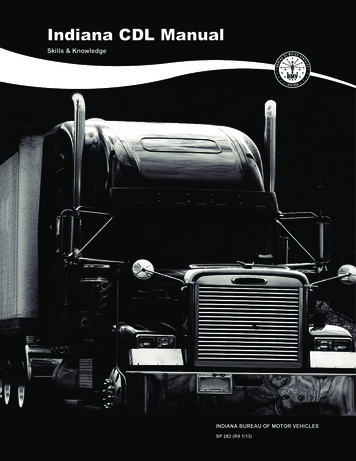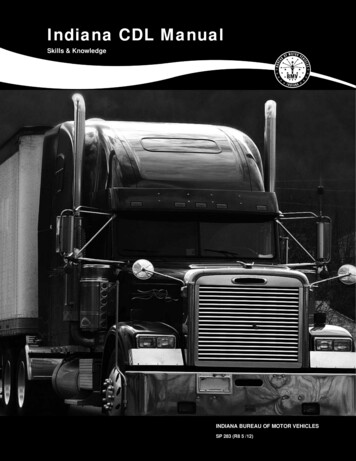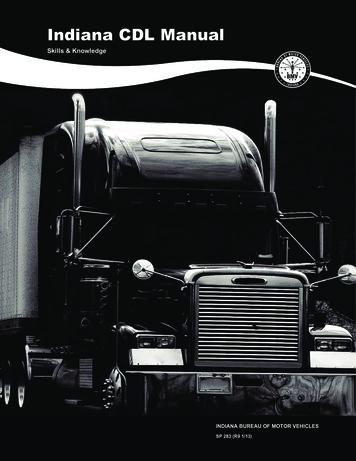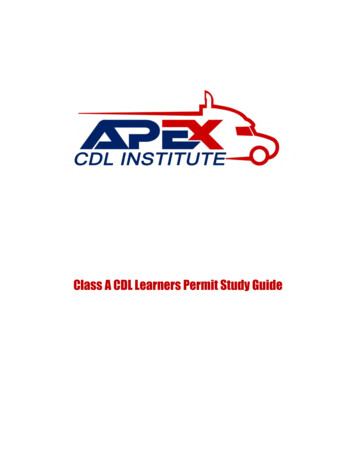
Transcription
Class A CDL Learners Permit Study Guide
2005 Model Commercial Driver’s License ManualSection 1INTRODUCTIONNoDoes the vehicle orcombination of vehicleshave a manufacturer’sweight rating (GVWR)over 26,000 pounds?This Section CoversYes Commercial Driver License TestsDriver DisqualificationsOther Safety RulesIs the vehicleacombinationvehicletowing a unitover 10,000poundsGVWR?There is a federal requirement that each state haveminimum standards for the licensing of commercialdrivers.This manual provides driver license testinginformation for drivers who wish to have acommercial driver license (CDL). This manual doesNOT provide information on all the federal andstate requirements needed before you can drive acommercial motor vehicle (CMV). You may have tocontact your state driver licensing authority foradditional information.Youneed aClass ACDL.NoDoes thesingleYesvehicle havea GVWRover 26,000pounds?You must have a CDL to operate:Any single vehicle with a gross vehicle weightrating (GVWR) of 26,001 pounds or more.YesYouneed aClass BCDL.NoIs the vehicledesigned tocarry 16 ormore people(includingthe driver)?A combination vehicle with a gross combinationweight rating of 26,001 or more pounds, if thetrailer(s) has a GVWR of 10,001 or more pounds.A vehicle designed to transport 16 or morepassengers (including the driver).Any size vehicle which requires hazardous materialplacards or is carrying material listed as a selectagent or toxin in 42 CFR part 73. Federalregulations through the Department of HomelandSecurity require a background check andfingerprinting for the Hazardous Materialsendorsement. Contact your local department ofdriver licensing for more information.YesYouneed aClass CCDL.NoNoDoes thevehiclerequirehazardousmaterialplacards ortransport aselect agentor toxin?(Your state may have additional definitions ofCMVs.)To get a CDL, you must pass knowledge and skillstests. This manual will help you pass the tests.This manual is not a substitute for a truck drivertraining class or program. Formal training is themost reliable way to learn the many special skillsrequired for safely driving a large commercialvehicle and becoming a professional driver in thetrucking industry.YesYesYouneed aClass CCDL.NoYou DO NOTneed a CDL.NOTE:A bus may be Class A, B, or C depending on whetherthe GVWR is over 26,001 pounds or is a combinationvehicle.Figure 1.1Figure 1.1 helps you determine if you need a CDL.Do You Need a CDL?Section 1 - IntroductionPage 1-1
2005 Model Commercial Driver’s License Manual1.1 – Commercial Driver License Tests1.1.1 – Knowledge Tests2XXX3XXX45*X6XXXSchool BusXPassengerXTank VehiclesXDouble / TripleSection 1 - Introduction1ENDORSEMENTHazardousMaterialsBasic Vehicle Control. You will be tested on yourskill to control the vehicle. You will be asked tomove your vehicle forward, backward, and turn itwithin a defined area. These areas may be markedwith traffic lanes, cones, barriers, or somethingsimilar. The examiner will tell you how each controltest is to be done.Class CPre-trip Vehicle Inspection. You will be tested tosee if you know whether your vehicle is safe todrive. You will be asked to do a pre-trip inspectionof your vehicle and explain to the examiner whatyou would inspect and why.LICENSETYPEClass BIf you pass the required knowledge test(s), you cantake the CDL skills tests. There are three types ofgeneral skills that will be tested: pre-trip inspection,basic vehicle control, and on-road driving. Youmust take these tests in the type of vehicle forwhich you wish to be licensed. Any vehicle thathas components marked or labeled cannot beused for the Pre-Trip Inspection Test.What Sections Should You Study?Class A1.1.2 – Skills TestsFigure 1.2 details which sections of this manualyou should study for each particular class oflicense and for each endorsement.Sections to StudyYou will have to take one or more knowledge tests,depending on what class of license and whatendorsements you need. The CDL knowledgetests include:The general knowledge test, taken by allapplicants.The passenger transport test, taken by all busdriver applicants.The air brakes test, which you must take if yourvehicle has air brakes, including air over hydraulicbrakes.The combination vehicles test, which is required ifyou want to drive combination vehicles.The hazardous materials test, required if you wantto haul hazardous materials as defined in 49 CFR383.5. In order to obtain this endorsement you arealso required to pass a Transportation SecurityAdministration (TSA) background check.The tanker test, required if you want to haul a liquidor liquid gas in a permanently mounted cargo tankrated at 119 gallons or more or a portable tankrated at 1,000 gallons or more.The doubles/triples test, required if you want to pulldouble or triple trailers.The School Bust test, required if you want to drivea school bus.On-road Test. You will be tested on your skill tosafely drive your vehicle in a variety of trafficsituations. The situations may include left and rightturns, intersections, railroad crossings, curves, upand down grades, single or multi-lane roads,streets, or highways. The examiner will tell youwhere to X*Study section 5 if you plan to operate vehiclesequipped with air brakes.Figure 1.2Page 1-2
2005 Model Commercial Driver’s License Manual1.2 – Driver Disqualifications1.2.1 – GeneralYou may not drive a commercial motor vehicle ifyou are disqualified for any reason.1.2.2 – Alcohol, Leaving the Scene of anAccident, and Commission of a FelonyIt is illegal to operate a CMV if your blood alcoholconcentration (BAC) is .04% or more. If youoperate a CMV, you shall be deemed to havegiven your consent to alcohol testing, which is calledimplied consent.You will lose your CDL for at least one year for afirst offense for:Driving a CMV if your blood alcohol concentrationis .04% or higher.Driving a CMV under the influence of alcohol.Refusing to undergo blood alcohol testing.Driving a CMV while under the influence of acontrolled substance.Leaving the scene of an accident involving a CMV.Committing a felony involving the use of a CMV.Driving a CMV when the CDL is suspended.Causing a fatality through negligent operation of aCMV.You will lose your CDL for at least three years ifthe offense occurs while you are operating a CMVthat is placarded for hazardous materials.You will lose your CDL for life for a second offense.You will lose your CDL for life if you use a CMV tocommit a felony involving controlled substances.You will be put out-of-service for 24 hours if youhave any detectable amount of alcohol under.04%.1.2.3 – Serious Traffic ViolationsSerious traffic violations are excessive speeding(15 mph or more above the posted limit), recklessdriving, improper or erratic lane changes, followinga vehicle too closely, traffic offenses committed ina CMV in connection with fatal traffic accidents,driving a CMV without obtaining a CDL or having aCDL in the driver’s possession, and driving a CMVwithout the proper class of CDL and/orendorsements.Section 1 - IntroductionYou will lose your CDL:For at least 60 days if you have committed twoserious traffic violations within a three-year periodinvolving a CMV.For at least 120 days for three or more serioustraffic violations within a three-year period involvinga CMV.1.2.4 – Violation of Out-of-Service OrdersYou will lose your CDL:[For at least 90 days if you have committed yourfirst violation of an out-of-service order.For at least one year if you have committed twoviolations of an out-of-service order in a ten-yearperiod.For at least three years if you have committedthree or more violations of an out-of-service orderin a ten-year period].1.2.5 – Railroad-highway Grade CrossingViolationsYou will lose your CDL:For at least 60 days for your first violation.For at least 120 days for your second violationwithin a three-year period.For at least one year for your third violation within athree-year period.These violations include violation of a federal, stateor local law or regulation pertaining to one of thefollowing six offenses at a railroad-highway gradecrossing:For drivers who are not required to always stop,failing to stop before reaching the crossing if thetracks are not clear.For drivers who are not required to always stop,failing to slow down and check that the tracks areclear of an approaching train.For drivers who are always required to stop, failingto stop before driving onto the crossing.For all drivers failing to have sufficient space todrive completely through the crossing withoutstopping.For all drivers failing to obey a traffic control deviceor the directions of an enforcement official at thecrossing.For all drivers failing to negotiate a crossingbecause of insufficient undercarriage clearance.Page 1-3
2005 Model Commercial Driver’s License Manual1.2.6 – Hazardous Materials EndorsementBackground Check and DisqualificationsIf you require a hazardous materials endorsementyou will be required to submit your fingerprints andbe subject to a background check.You will be denied or you will lose your hazardousmaterials endorsement if you:Are not a lawful permanent resident of the UnitedStates.Renounce your United States citizenship.Are wanted or under indictment for certain felonies.Have a conviction in military or civilian court forcertain felonies.Have been adjudicated as a mental defective orcommitted to a mental institution.Are considered to pose a security threat asdetermined by the Transportation SecurityAdministration.The background check procedures vary fromjurisdiction to jurisdiction. Your licensing agencywill provide you with all the information you need tocomplete the required TSA background checkprocedures.1.2.7 – Traffic Violations in Your PersonalVehicleThe Motor Carrier Safety Improvement Act(MCSIA) of 1999 requires a CDL holder to bedisqualified from operating a commercial motorvehicle if the CDL holder has been convicted ofcertain types of moving violations in their personalvehicle.If your privilege to operate your personal vehicle isrevoked, cancelled, or suspended due to violationsof traffic control laws (other than parking violations)you will also lose your CDL driving privileges.If your privilege to operate your personal vehicle isrevoked, cancelled, or suspended due to alcohol,controlled substance or felony violations, you willlose your CDL for 1 year. If you are convicted of asecond violation in your personal vehicle or CMVyou will lose your CDL for life.If your license to operate your personal vehicle isrevoked, cancelled, or suspended you may notobtain a “hardship” license to operate a CMV.1.3 – Other CDL RulesThere are other federal and state rules that affectdrivers operating CMVs in all states. Among themare:Section 1 - IntroductionYou cannot have more than one license. If youbreak this rule, a court may fine you up to 5,000or put you in jail and keep your home state licenseand return any others.You must notify your employer within 30 days ofconviction for any traffic violations (except parking).This is true no matter what type of vehicle youwere driving.You must notify your motor vehicle licensingagency within 30 days if you are convicted in anyother jurisdiction of any traffic violation (exceptparking). This is true no matter what type of vehicleyou were driving.You must notify your employer within two businessdays if your license is suspended, revoked, orcanceled, or if you are disqualified from driving.You must give your employer information on alldriving jobs you have held for the past 10 years.You must do this when you apply for a commercialdriving job.No one can drive a commercial motor vehiclewithout a CDL. A court may fine you up to 5,000or put you in jail for breaking this rule.If you have a hazardous materials endorsementyou must notify and surrender your hazardousmaterials endorsement to the state that issuedyour CDL within 24 hours of any conviction orindictment in any jurisdiction, civilian or military, for,or found not guilty by reason of insanity of adisqualifying crime listed in 49 CFR 1572.103; whois adjudicated as a mental defective or committedto a mental institution as specified in 49 CFR1572.109; or who renounces his or her U. S.citizenship;Your employer may not let you drive a commercialmotor vehicle if you have more than one license orif you’re CDL is suspended or revoked. A courtmay fine the employer up to 5,000 or put him/herin jail for breaking this rule.All states are connected to one computerizedsystem to share information about CDL drivers.The states will check on drivers' accident recordsto be sure that drivers do not have more than oneCDL.You must be properly restrained by a safety belt atall times while operating a commercial motorvehicle. The safety belt design holds the driversecurely behind the wheel during a crash, helpingthe driver to control the vehicle and reduces thechance of serious injury or death. If you do notwear a safety belt, you are four times more likely tobe fatally injured if you are thrown from the vehicle.Your state may have additional rules that you mustalso obey.Page 1-4
2005 Commercial Driver’s License ManualSection 2DRIVING SAFELYThis Section Covers Vehicle InspectionBasic Control of Your VehicleShifting GearsSeeingCommunicatingSpace ManagementControlling Your SpeedSeeing HazardsDistracted DrivingAggressive Drivers/Road RageNight DrivingDriving in FogWinter DrivingHot Weather DrivingRailroad-highway CrossingsMountain DrivingDriving EmergenciesAntilock Braking SystemsSkid Control and RecoveryAccident ProceduresFiresAlcohol, Other Drugs, and DrivingStaying Alert and Fit to DriveHazardous Materials RulesThis section contains knowledge and safe drivinginformation that all commercial drivers shouldknow. You must pass a test on this information toget a CDL. This section does not have specificinformation on air brakes, combination vehicles,doubles, or passenger vehicles. When preparingfor the Pre-trip Inspection Test, you must reviewthe material in Section 11 in addition to theinformation in this section. This section does havebasic information on hazardous materials (HazMat)that all drivers should know. If you need a HazMatendorsement, you should study Section 9.Section 2 – Driving Safely2.1 – Vehicle Inspection2.1.1 – Why InspectSafety is the most important reason you inspectyour vehicle, safety for yourself and for other roadusers.A vehicle defect found during an inspection couldsave you problems later. You could have abreakdown on the road that will cost time anddollars, or even worse, a crash caused by thedefect.Federal and state laws require that drivers inspecttheir vehicles. Federal and state inspectors alsomay inspect your vehicles. If they judge the vehicleto be unsafe, they will put it "out of service" until itis fixed.2.1.2 – Types of Vehicle InspectionPre-trip Inspection. A pre-trip inspection will helpyou find problems that could cause a crash orbreakdown.During a Trip. For safety you should:Watch gauges for signs of trouble.Use your senses to check for problems (look,listen, smell, feel).Check critical items when you stop: Tires, wheels and rims. Brakes. Lights and reflectors. Brake and electrical connections to trailer. Trailer coupling devices. Cargo securement devices.After-trip Inspection and Report. You should doan after-trip inspection at the end of the trip, day, ortour of duty on each vehicle you operated. It mayinclude filling out a vehicle condition report listingany problems you find. The inspection report helpsa motor carrier know when the vehicle needsrepairs.Page 2-1
2005 Commercial Driver’s License Manual2.1.3 – What to Look ForTire ProblemsToo much or too little air pressure.Bad wear. You need at least 4/32-inch tread depthin every major groove on front tires. You need 2/32inch on other tires. No fabric should show throughthe tread or sidewall.Cuts or other damage.Tread separation.Dual tires that come in contact with each other orparts of the vehicle.Mismatched sizes.Radial and bias-ply tires used together.Cut or cracked valve stems.Regrooved, recapped, or retreaded tires on thefront wheels of a bus. These are prohibited.Wheel and Rim ProblemsDamaged rims.Rust around wheel nuts may mean the nuts areloose--check tightness. After a tire has beenchanged, stop a short while later and re-checktightness of nuts.Missing clamps, spacers, studs, or lugs meansdanger.Mismatched, bent, or cracked lock rings aredangerous.Wheels or rims that have had welding repairs arenot safe.Bad Brake Drums or ShoesCracked drums.Shoes or pads with oil, grease, or brake fluid onthem.Shoes worn dangerously thin, missing, or broken.Steering System DefectsMissing nuts, bolts, cotter keys, or other parts.Bent, loose, or broken parts, such as steeringcolumn, steering gear box, or tie rods.If power steering equipped, check hoses, pumps,and fluid level; check for leaks.Steering wheel play of more than 10 degrees(approximately 2 inches movement at the rim of a20-inch steering wheel) can make it hard to steer.Figure 2.1Suspension System Defects. The suspensionsystem holds up the vehicle and its load. It keepsthe axles in place. Therefore, broken suspensionparts can be extremely dangerous. Look for:Spring hangers that allow movement of axle fromproper position. See Figure 2.2.Cracked or broken spring hangers.Missing or broken leaves in any leaf spring. If onefourth or more are missing, it will put the vehicle"out of service", but any defect could bedangerous. See Figure 2.3.Broken leaves in a multi-leaf spring or leaves thathave shifted so they might hit a tire or other part.Leaking shock absorbers.Torque rod or arm, u-bolts, spring hangers, orother axle positioning parts that are cracked,damaged, or missing.Air suspension systems that are damaged and/orleaking. See Figure 2.4.Any loose, cracked, broken, or missing framemembers.Figure 2.1 illustrates a typical steering system.Section 2 – Driving SafelyPage 2-2
2005 Commercial Driver’s License ManualFigure 2.4Figure 2.2Exhaust System Defects. A broken exhaustsystem can let poison fumes into the cab orsleeper berth. Look for:Loose, broken, or missing exhaust pipes, mufflers,tailpipes, or vertical stacks.Loose, broken, or missing mounting brackets,clamps, bolts, or nuts.Exhaust system parts rubbing against fuel systemparts, tires, or other moving parts of vehicle.Exhaust system parts that are leaking.Emergency Equipment. Vehicles must beequipped with emergency equipment. Look for:Fire extinguisher(s).Spare electrical fuses (unless equipped with circuitbreakers).Warning devices for parked vehicles (for example,three reflective warning triangles).Cargo (Trucks). You must make sure the truck isnot overloaded and the cargo is balanced andsecured before each trip. If the cargo containshazardous materials, you must inspect for properpapers and placarding.2.1.4 – CDL Pre-trip Vehicle Inspection TestFigure 2.3Section 2 – Driving SafelyIn order to obtain a CDL you will be required topass a pre-trip vehicle inspection test. You will betested to see if you know whether your vehicle issafe to drive. You will be asked to do a pre-tripinspection of your vehicle and explain to theexaminer what you would inspect and why. Thefollowing seven-step inspection method should beuseful.Page 2-3
2005 Commercial Driver’s License Manual2.1.5 – Seven-step Inspection MethodMethod of Inspection. You should do a pre-tripinspection the same way each time so you willlearn all the steps and be less likely to forgetsomething.Approaching the Vehicle. Notice generalcondition. Look for damage or vehicle leaning toone side. Look under the vehicle for fresh oil,coolant, grease, or fuel leaks. Check the areaaround the vehicle for hazards to vehiclemovement (people, other vehicles, objects, lowhanging wires, limbs, etc.).Lower and secure hood, cab, or enginecompartment door.Step 3: Start Engine and Inspect Inside the CabGet In and Start EngineMake sure parking brake is on.Put gearshift in neutral (or "park" if automatic).Start engine; listen for unusual noises.If equipped, check the Anti-lock Braking System(ABS) indicator lights. Light on dash should comeon and then turn off. If it stays on the ABS is notworking properly. For trailers only, if the yellowlight on the left rear of the trailer stays on, the ABSis not working properly.Vehicle Inspection GuideStep 1: Vehicle OverviewReview Last Vehicle Inspection Report. Driversmay have to make a vehicle inspection report inwriting each day. The motor carrier must repair anyitems in the report that affect safety and certify onthe report that repairs were made or wereunnecessary. You must sign the report only ifdefects were noted and certified to be repaired ornot needed to be repaired.Step 2: Check Engine CompartmentCheck That the Parking Brakes Are On and/orWheels Chocked.You may have to raise the hood, tilt the cab(secure loose things so they don't fall and breaksomething), or open the engine compartment door.Check the following:Engine oil level.Coolant level in radiator; condition of hoses.Power steering fluid level; hose condition (if soequipped).Windshield washer fluid level.Battery fluid level, connections, and tie downs(battery may be located elsewhere).Automatic transmission fluid level (may requireengine to be running).Check belts for tightness and excessive wear(alternator, water pump, air compressor)--learnhow much "give" the belts should have whenadjusted right, and check each one.Leaks in the engine compartment (fuel, coolant, oil,power steering fluid, hydraulic fluid, battery fluid).Cracked, worn electrical wiring insulation.Section 2 – Driving SafelyLook at the GaugesOil pressure. Should come up to normal withinseconds after engine is started. See Figure 2.5Air pressure. Pressure should build from 50 to 90psi within 3 minutes. Build air pressure to governorcut-out (usually around 120 – 140 psi. Know yourvehicles requirements.Ammeter and/or voltmeter. Should be in normalrange(s).Coolant temperature. Should begin gradual rise tonormal operating range.Engine oil temperature. Should begin gradual riseto normal operating range.Warning lights and buzzers. Oil, coolant, chargingcircuit warning, and antilock brake system lightsshould go out right away.Check Condition of Controls. Check all of thefollowing for looseness, sticking, damage, orimproper setting:Steering wheel.Clutch.Accelerator ("gas pedal").Brake controls. Foot brake. Trailer brake (if vehicle has one). Parking brake. Retarder controls (if vehicle has them).Transmission controls.Interaxle differential lock (if vehicle has one).Horn(s).Windshield wiper/washer.Lights. Headlights. Dimmer switch. Turn signal.Page 2-4
2005 Commercial Driver’s License Manual Four-way flashers. Parking, clearance, identification, markerswitch(es).Step 5: Do Walkaround InspectionGo to front of vehicle and check that low beamsare on and both of the four-way flashers areworking.Push dimmer switch and check that high beamswork.Turn off headlights and four-way emergencyflashers.Turn on parking, clearance, side-marker, andidentification lights.Turn on right turn signal, and start walk-aroundinspection.GeneralWalkaround and inspect.Clean all lights, reflectors, and glass as you goalong.Figure 2.5Check Mirrors and Windshield. Inspect mirrorsand windshield for cracks, dirt, illegal stickers, orother obstructions to seeing clearly. Clean andadjust as necessary.Check Emergency EquipmentCheck for safety equipment: Spare electrical fuses (unless vehicle hascircuit breakers). Three red reflective triangles. Properly charged and rated fire extinguisher.Check for optional items such as: Chains (where winter conditions require). Tire changing equipment. List of emergency phone numbers Accident reporting kit (packet).Left Front SideDriver's door glass should be clean.Door latches or locks should work properly.Left front wheel. Condition of wheel and rim--missing, bent,broken studs, clamps, lugs, or any signs ofmisalignment. Condition of tires--properly inflated, valvestem and cap OK, no serious cuts, bulges,or tread wear. Use wrench to test rust-streaked lug nuts,indicating looseness. Hub oil level OK, no leaks.Left front suspension. Condition of spring, spring hangers,shackles, u-bolts. Shock absorber condition.Left front brake. Condition of brake drum or disc. Condition of hoses.Check Safety Belt. Check that the safety belt issecurely mounted, adjusts, latches properly and isnot ripped or frayed.Step 4: Turn Off Engine and Check LightsMake sure the parking brake is set, turn off theengine, and take the key with you. Turn onheadlights (low beams) and four-way emergencyflashers, and get out of the vehicle.Section 2 – Driving SafelyPage 2-5
2005 Commercial Driver’s License ManualFrontCondition of front axle.Condition of steering system. No loose, worn, bent, damaged or missingparts. Must grab steering mechanism to test forlooseness.Condition of windshield. Check for damage and clean if dirty. Check windshield wiper arms for properspring tension. Check wiper blades for damage, "stiff"rubber, and securement.Lights and reflectors. Parking, clearance, and identification lightsclean, operating, and proper color (amber atfront). Reflectors clean and proper color (amber atfront). Right front turn signal light clean, operating,and proper color (amber or white on signalsfacing forward).Right SideRight front: check all items as done on left front.Primary and secondary safety cab locks engaged(if cab-over-engine design).Right fuel tank(s). Securely mounted, not damaged, or leaking. Fuel crossover line secure. Tank(s) contain enough fuel. Cap(s) on and secure.Condition of visible parts. Rear of engine--not leaking. Transmission--not leaking. Exhaust system--secure, not leaking, nottouching wires, fuel, or air lines. Frame and cross members--no bends orcracks. Air lines and electrical wiring--securedagainst snagging, rubbing, wearing. Spare tire carrier or rack not damaged (if soequipped). Spare tire and/or wheel securely mounted inrack. Spare tire and wheel adequate (proper size,properly inflated).Cargo securement (trucks). Cargo properly blocked, braced, tied,chained, etc. Header board adequate, secure (if required).Section 2 – Driving Safely Side boards, stakes strong enough, free ofdamage, properly set in place (if soequipped). Canvas or tarp (if required) properly securedto prevent tearing, billowing, or blocking ofmirrors. If oversize, all required signs (flags, lamps,and reflectors) safely and properly mountedand all required permits in driver'spossession. Curbside cargo compartment doors in goodcondition, securely closed, latched/lockedand required security seals in place.Right RearCondition of wheels and rims--no missing, bent, orbroken spacers, studs, clamps, or lugs.Condition of tires--properly inflated, valve stemsand caps OK, no serious cuts, bulges, tread wear,tires not rubbing each other, and nothing stuckbetween them.Tires same type, e.g., not mixed radial and biastypes.Tires evenly matched (same sizes).Wheel bearing/seals not leaking.Suspension. Condition of spring(s), spring hangers,shackles, and u-bolts. Axle secure. Powered axle(s) not leaking lube (gear oil). Condition of torque rod arms, bushings. Condition of shock absorber(s). If retractable axle equipped, check conditionof lift mechanism. If air powered, check forleaks. Condition of air ride components.Brakes. Brake adjustment. Condition of brake drum(s) or discs. Condition of hoses--look for any wear due torubbing.Lights and reflectors. Side-marker lights clean, operating, andproper color (red at rear, others amber). Side-marker reflectors clean and propercolor (red at rear, others amber).Page 2-6
2005 Commercial Driver’s License ManualRearLights and reflectors. Rear clearance and identification lightsclean, operating, and proper color (red atrear). Reflectors clean and proper color (red atrear). Taillights clean, operating, and proper color(red at rear). Right rear turn signal operating, and propercolor (red, yellow, or amber at rear).License plate(s) present, clean, and secured.Splash guards present, not damaged, properlyfastened, not dragging on ground, or rubbing tires.Cargo secure (trucks).Cargo properly blocked, braced, tied, chained, etc.Tailboards up and properly secured.End gates free of damage, properly secured instake sockets.Canvas or tarp (if required) properly secured toprevent tearing, billowing, or blocking of either therearview mirrors or rear lights.If over-length, or over-width, make sure all signsand/or additional lights/flags are safely andproperly mounted and all required permits are indriver's possession.Rear doors securely closed, latched/locked.Left SideCheck all items as done on right side, plus: Battery(ies) (if not mounted in enginecompartment). Battery box(es) securely mounted to vehicle. Box has secure cover. Battery(ies) secured against movement. Battery(ies) not broken or leaking. Fluid in battery(ies) at proper level (exceptmaintenance-free type). Cell caps present and securely tightened(except maintenance-free type). Vents in cell caps free of foreign material(except maintenance-free type).Step 6: Check Signal LightsGet In and Turn Off LightsTurn off all lights.Turn on stop lights (apply trailer hand brake orhave a helper put on the brake pedal).Turn on left turn signal lights.Section 2 – Driving SafelyGet Out and Check LightsLeft front turn signal light clean, operating andproper color (amber or white on signals facing thefront).Left rear turn signal light and both stop lights clean,operating, and proper color (red, yellow, or amber).Get In VehicleTurn off lights not needed for driving.Check for all required papers, trip manifests,permits, etc.Secure all loose articles in cab (they might interferewith operation of the controls or hit you in a crash).Start the engine.Step 7: Start
To get a CDL, you must pass knowledge and skills tests. This manual will help you pass the tests. This manual is not a substitute for a truck driver training class or program. Formal training is the most reliable way to learn the many special skills required for safely driving a large commercial
